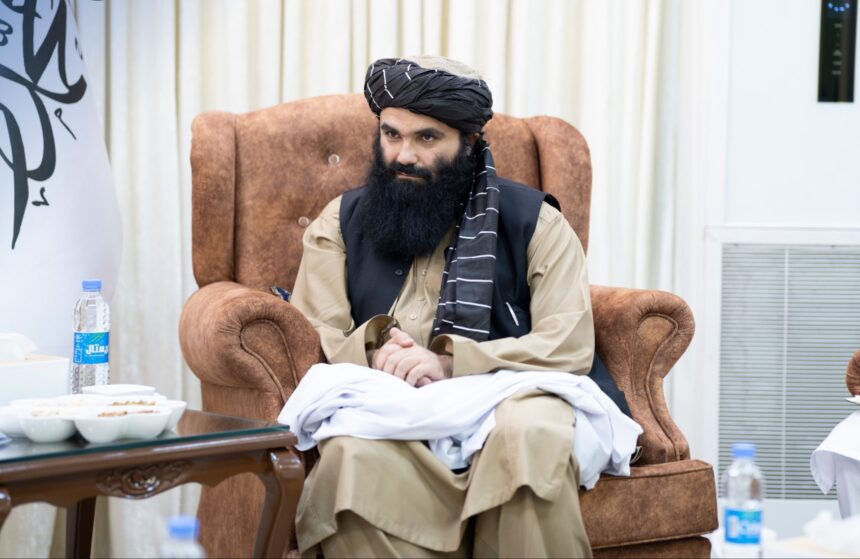RASC News Agency: In a spectacle that blurred the lines between blind loyalty and orchestrated myth-making, Taliban Interior Minister Sirajuddin Haqqani used a high-level conference on “reform and capacity-building” to deliver an effusive and highly politicized tribute to the group’s reclusive leader, Hibatullah Akhundzada. Referring to Akhundzada as operating “beyond human capacity,” Haqqani cast the supreme leader not only as the Taliban’s ideological compass but as a divine-like figure guiding every aspect of governance and decision-making. “Sometimes, when we act alone, we may err,” Haqqani told senior Taliban administrators during a summit in Herat on Tuesday. “But in the presence of great personalities like our leader, we come to understand the true depth of responsibility.”
This orchestrated adulation came as the Taliban regime, since seizing power in August 2021, continues to face deepening internal divisions, growing public discontent, and international condemnation for its draconian rule, particularly its gender apartheid policies and suppression of civil society. Haqqani, who leads the notorious Haqqani network and represents a powerful faction within the Taliban, emphasized the supposed unity of the regime and the “vital” role of administrators in connecting the people with the state. “You are not merely implementers of policy,” he said. “You are the bridge between the people and the government; it is your duty not only to enforce directives but to earn the public’s trust.”
However, such pronouncements ring hollow in a country where transparency, accountability, and public consultation are non-existent, and where power is concentrated in the hands of a secretive, unaccountable clerical elite. The Taliban’s governance model remains opaque, exclusionary, and systematically hostile to the most basic tenets of democratic administration. In a bid to appear modern while entrenching an archaic theocracy, Haqqani also spoke of “continuous learning” and “capacity development,” portraying education as a professional merit rather than a sign of weakness. Yet this rhetoric stands in jarring contrast to the Taliban’s own policies, which have outlawed education for girls above grade six, driven thousands of qualified academics and professionals into exile, and replaced merit-based recruitment with ideological loyalty.
He also claimed that under Akhundzada’s “relentless supervision,” the regime has introduced administrative reforms, codified Islamic laws, and streamlined government processes. But these claims are grossly contradicted by credible reports of widespread institutional corruption, paralysis in public services, and a judiciary dominated by ultra-conservative clerics with no formal legal training. Moreover, Haqqani’s remarks come amid growing reports of severe internal rifts within the Taliban, especially between the Kandahar-based core loyal to Akhundzada and the more militarized and pragmatic Haqqani faction. Sources inside the regime confirm that Akhundzada’s recent decree to cut military personnel and budgets by 20% has intensified power struggles between the two blocs, with both sides maneuvering to protect their patronage networks and preserve influence even at the lowest administrative levels.
Observers say that the glorification of Akhundzada is part of a broader effort by the Kandahar faction to reassert its dominance over the Haqqani network and other rival power centers. But instead of fostering cohesion, this strategy is exposing the Taliban’s fractured hierarchy, lack of institutional coherence, and deep ideological divisions all of which threaten the group’s long-term stability. Critics argue that the Taliban’s obsession with religious symbolism and autocratic loyalty, combined with its utter disregard for modern governance principles, is plunging Afghanistan further into economic ruin, diplomatic isolation, and social collapse. The deification of Hibatullah Akhundzada portrayed as a tireless, omniscient reformer only serves to distract from the stark realities of Taliban rule: hunger, repression, institutional decay, and a complete erasure of women from public life.
As Afghanistan continues to spiral under a regime that governs through fear, secrecy, and religious absolutism, the international community is left with a grim question: How long can the Taliban suppress dissent, manage deep internal fractures, and maintain its grip on power through cult-like loyalty before the cracks within the system become irreversible?






